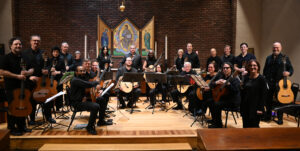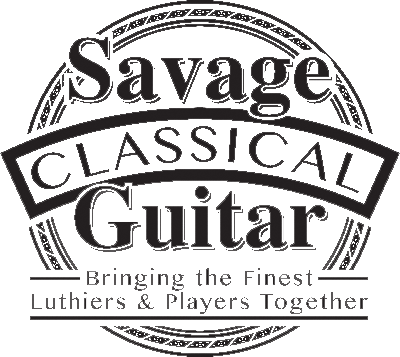by J. Scott Matejicka
June 2006
With a myriad of guitar-related topics before us, I would like to jump straight to the end product and discuss performance practice. Performing a musical work can be an extremely rewarding experience. But just like every other aspect of musical development, the art of performing must be practiced and prepared for.
Preparation
Performance practice begins well before the first note of a piece is played; it begins even before one steps foot on stage. As a performance nears, one must mentally prepare to share his art. During each regular practice session, set aside time to run your piece in performance mode. Frame your piece with silence. This will provide clarity for your listeners. As in a true performance, do not allow yourself to stop to fix things or even rearticulate a note that didn’t come out quite right. You will soon develop the ability to present the music as an artistic whole. Make mental notes of elements you would like to alter, but stay with the performance. In this stage of preparation, one of the main goals is to communicate with the audience. Project your sound (as well as all of your musical ideas) to the back of the room. Record your performance for immediate feedback. Make sure the interpretive elements you hear in your head are actually coming out of your guitar!
Over time, you will figure out what you need both mentally and physically to ensure a positive performance experience. Sleep, diet and mental preparation should all be taken into consideration. Visualization of the entire performance should become a part of your normal practice regimen. From the moments just before you walk on stage to the performance of the actual piece (including the final bow), all elements of performance should be practiced mentally, well before your performance date arrives. On the day of the performance, some players prefer to conserve their energy. They warm up, but don’t overdo it. Others prefer to continually run their pieces until it’s time go on stage.
I often hear people say, “But all my practicing goes out the window when I get up on stage. I get so nervous.” Nerves can be the most crippling obstacle in a performance. Everyone deals with a certain amount of nervousness when dealing with something important. Nerves are the body’s natural “fight or flight” mechanism kicking in. You must harness this energy and change it into something positive. In this state, your body possesses a heightened sense of awareness. When on stage, it is easy to second-guess yourself due to nervousness, so be precise in your preparation. Fuzzy areas in practice will come back to haunt you in performance.
The adrenaline rush is inevitable. Your body just needs time to acclimate itself. Don’t fight it! The rush will happen, but with practice, you can control when it happens. If you fight the sensation, it may happen just after your opening few notes resulting in an unstable beginning. When working in performance mode, visualize the audience to get the adrenaline pumping. This will help you become familiar with this heightened state of awareness offstage so there are no surprises onstage.
Presentation
Guitarists new to performing often focus so much on playing the piece correctly that presentation and deportment are neglected. How you present yourself is as important as how the piece is played. As a performer, you must exude a personality larger than what you may be used to. Walk on stage with confidence and command attention. This new attitude should have begun on the way to the performance space (if not before). Once you reach the seat, address the audience with your eyes. Some performers prefer to stop and bow adjacent to the seat, outside of the performance circle. Some prefer to stop in front of the chair. If the audience welcomes you with applause, bow. Never bow to a silent audience.
Once seated, take your time and quietly check your tuning. Then assume the character of the piece you are about to play. Establish the performance tempo in your head. You do not want to begin the piece and use the first measure or two to figure out the tempo. In your practice room, you will have already experienced beginning the piece from a point of silence countless times. This preparation will help you avoid a false start. Once the opening note is played, stay in character. On a certain level, the audience no longer exists. It’s just you, the guitar and the notes of the composer. Ultimately, you will be able to let go and trust your ability. If something doesn’t go as planned, don’t make a face! More often than not, the audience is oblivious to any mistakes you might make, so it’s best not to react in a way that would draw attention to errors. As the last note of the piece is played, stay in character. The rhythmic duration of the last note must be realized! Too many guitarists leave it up to the instrument to take care of the musical sustain of the final note or chord. Treat these last moments as if you were actually singing the note. The manner in which you finally cut off the guitar should also reflect the character of the piece. The aesthetic of the composition should always be taken into consideration when cutting off. In general, slow pieces need a little more time to settle. So, when you silence the strings, stay still. Wait a second or two before you drop out of character.
Once out of character, address the audience again with your eyes. Stand (some performers prefer to move outside of the performer’s circle), don’t forget to smile (regardless of how you personally assessed your success) and allow the audience to enjoy the moment. Whether you feel a personal sense of accomplishment or not, the audience may have just experienced the single most moving artistic event in their life! Don’t deprive them of that by displaying any form of negative self-assessment. Then, slowly bow, address the audience again with your eyes and confidently walk offstage.
Your obligation as a performer doesn’t end once you leave the stage. Accept compliments from audience members graciously. Always sustain your professional demeanor in the eyes of the public.
Remember that performance practice is a process. If you are not a seasoned performer, do not perform a piece that exceeds your musical and technical ability. Use an accessible piece that allows you to focus on your main objective — which is to perform well. If using the score will secure a positive experience, use it. As the elements of successful performance come into focus, challenge yourself with slightly more demanding pieces. Performance is always an introspective journey. You decide yes, I will perform, or no, not this time. If you decide to perform, completely commit to the task and don’t turn back. Each performance affords you an opportunity to develop a skill that will ultimately result in an artful, moving experience for you and all of your listeners.









